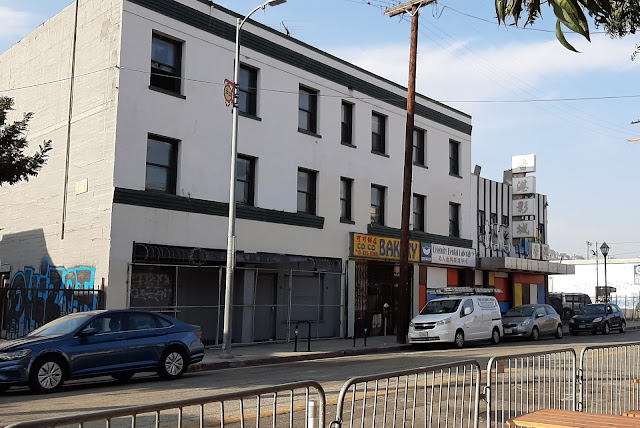Opened: 1962, initially called the
Sing Lee Theatre. It's on the west side of the street a half block north of Cesar Chavez Ave. It has a long lobby. That's the auditorium over on the right. Photo: Bill Counter - 2020
Architect: Gilbert L. Leong. The L.A. Conservancy, in "Exploring Chinatown: Past and Present," notes that he was a native of Los Angeles and the first Chinese-American to graduate from USC's School of Architecture. The Conservancy's booklet is available as a PDF.
Seating: 425
A 1988 writeup located by Ken McIntyre. He included this as part of a 2023 thread about suspected Chinatown gambling dens for the private Facebook group Photos of Los Angeles.
Closing: It closed as a film house in 2001, according to the L.A. Conservancy.
Quentin Tarantino was evidently interested in buying the house around 2003 but he didn't pursue a deal. Many Chinese films were stored in the theatre and
that library was going to be part of the transaction. The films later were donated by the building's owners to the UCLA Film and Television Archive.
One group wanted to take over the theatre in 2016. Corky Baines comments:
In October 2016 the theatre had a brief resurgence as a dance venue with performances of "When I Am King" by the Heidi Duckler Dance Theatre. For views of various areas of the building set up for the event see Sandi Hemmerlein's 2016 Avoiding Regret photo essay "A Dormant Chinatown Theatre Wakes Up To Dance."
Red Car Properties announced a renovation program in 2016 and was advertising the the availability of the theatre for short term rentals and special events. Curbed L.A. had a January 2017 story by Bianca Barrigan about Red Car's planned redevelopment of the site that would have included 200 units of housing. What specifically they planned to do with the theatre wasn't outlined. In any case, the project didn't proceed.
Status: The building is currently vacant, largely stripped out, and with a big hole in the roof. Presumably the project involving it is still a possibility for the future. The Red Car website has all sorts of interesting projects on it but the King Hing no longer appears there.
Lobby views:
A 2010 photo of the lobby by Dennis Bartok. He's the co-author, with Jeff Joseph, of the 2016 book "A Thousand Cuts: The Bizarre Underground World of the Collectors and Dealers who Saved the Movies." It's available from Amazon or your local bookseller. There's a preview on Google Books. Thanks to Ron Strong for passing along Dennis' photos. Visit his site Bijou Memories.
A view back to the booth from Sandi Hemmerlein's 2016 Avoiding Regret photo essay "A Dormant Chinatown Theatre Wakes Up To Dance."
The cache of prints of Chinese films stored backstage at the theatre. They were donated to the UCLA Film and Television Archive. Thanks to Corky Baines for his 2016 photo, added as a comment to a post on the Los Angeles Theatres Facebook page.
The auditorium in 2019. Thanks to Adam Piron for his photos. This is one of four posted on Twitter.
1960s - A look north on Spring toward the theatre when it was the Sing Lee. The photo appears on a fine 2012 History of Chinatown post by Elizabeth Uyeda on the site Los Angeles Revisited. Elizabeth credits the photo to the Seaver Center for Western History Research at the Natural History Museum of Los Angeles County.
1970 - The theatre was shut down as a suspected gambling casino. Thanks to Ken McIntyre for finding the newspaper item, added as a comment on a 2020 post about Chinatown theatres for the private Facebook group Photos of Los Angeles. This was also included by Ken in a 2023 post for the group that included clippings about other suspected Chinatown gambling dens shut down that year.
2009 - A facade view by Ken McIntyre
c.2010 - An image shared by Corky Baines on a Facebook post featuring various closed theatres.
c.2012 - A view north. Thanks to Elizabeth Uyeda for the photo, one appearing with her article about Chinatown on Los Angeles Revisited. The building occupying most of the image dates from 1890.
2014 - Looking south on Spring toward Cesar Chavez Ave. On the right of the photo we see auditorium of the theatre sprawling off toward New High St. Photo: Google Maps
c.2017 - Another shot by Dennis Bartok. Thanks!
2020 - A view from Marco Diaz on the private Facebook group Photos of Los Angeles. He was wondering what a translation was of the characters on the vertical sign. Marielena Tiscareño offered "Hong Kong Movie City" or "HK Movie Cinema" noting that apparently Cinema and City are the same word. Alex Fernandez suggested one of the characters means warrior.
2020 - Looking south toward Cesar Chavez Ave. Photo: Bill Counter
The theatre's signage is seen down the block in this shot from the final scene of Roman Polanski's "Chinatown" (Paramount, 1974). Thanks to Jordan Lage for spotting the theatre in the film. See the Historic L.A. Theatres in Movies post for three additional shots from the scene.
More Information: See the Cinema Treasures page on the King Hing Theatre.
| back to top | North of Downtown and East L.A. | Downtown theatres | Westside | Hollywood | Westwood and Brentwood | South, South Central and Southeast theatres | Along the Coast | [more] Los Angeles Movie Palaces | Los Angeles theatres - the main alphabetical list | Los Angeles theatres - list by address | theatre history resources | film and theatre tech resources | theatres in movies | LA Theatres on facebook | contact info | welcome and site navigation guide |









































Thank you for this. It seems that this old haunting place of mine is also gone for good. Great memories of this place.
ReplyDeleteMy go to place, 1970-76.
Delete